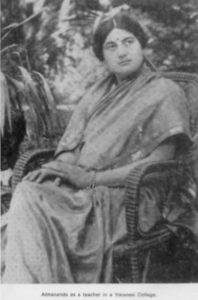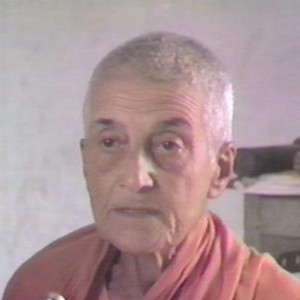AkhandanandaBholanath DidimaGurupriya Didi Paramananda
HaribabaBhaijiGopinath Kaviraj
Br TanmayanandaPanudaSwami KeshavanandaNarayan-Swami
Swami Nirvanananda
Br Atmananda
Blanca, a former Austrian aristocrat, would become a renunciate under Ma, receiving from Ma the name “Atmananda”. This lady, who outlived Ma by only several years, performed for Westerners an invaluable service by translating Ma’s teachings into English and other European languages.
Atmananda was born on June 7th, 1904 in Vienna, the capital of the Austrian Empire, which at the time included Hungary, Czechoslovakia, Yugoslavia and Poland. Her mother’s family came from Czechoslovakia, her father’s from Poland.
Watch Br Atmananda’s Interview on Youtube
Atmananda’s mother died when Atmananda’s sister was born. Atmananda then was two years old. The mother must have been a beautiful woman; a large picture of her hung in the bedroom. The two children were cared for by their maternal grandmother; their father had asked her to move into their flat when his wife had died.
In this wonderful lady’s life there had been many tragedies; she had lost her husband and her seven children. Her inherent love and kindness were now poured into the two beautiful little grandchildren. She kept house for them and their father. Graciousness radiated from her. She always wore black dresses, a sign of mourning in Europe.
Atmananda said that she often found her crying. This made Atmananda very sad. Atmananda’s father gave whatever money could buy to the two girls: Beautiful clothes and many books. Besides going to school tutors came into the house to teach them. They had music lessons at a young age and were taken to concerts and operas by a maternal uncle, a highly educated man.
When Atmananda was about eight years old she showed outstanding musical talent. The best available grand piano was bought for her and she took practicing very seriously. At an early age she also got very interested in literature and read widely. Her life was influenced by Russian writers, such as Tolstoy. She endeavored to live by his ideals.
Though Atmananda was very serious, she enjoyed being with friends, with whom she went for walks and spent lovely holidays in the mountains. But ill fate pursued the little family. Atmananda’s sister worked with devotion and energy for deprived young children. When she was seventeen years old, she caught diphtheria and died. Atmananda believed that since her sister had sacrificed herself for the good of others, her mission in life had been fulfilled.
Blanca (first called Ramanandi by Ma; Atmananda is the name given to her much later by Mataji) was deeply involved with Theosophy. She studied philosophic books and mixed with people who she thought were spiritually advanced. Searching for inner peace, she went to India for a short time to attend a Theosophical convention. Her piano playing had developed and was most beautiful and inspiring. But her art apparently did not give fulfillment for herself. She spent a few years in Holland as organist in a church connected with the Theosophical Society and then returned to Vienna.
These were the years of depression and her formerly wealthy father was now quite poor. It was an unhappy time for Blanca. One day a message came from Varanasi inviting her to teach at Rajghat School. Blanca felt compelled to go to India. Her grandmother was left alone. Blanca’s father rarely then stayed at home. It was very sad for the grandmother and for Blanca. Atmananda did wonderful teaching at Rajghat School. Deep friendships were formed, but all these were only stepping stones in Atmananda’s life. Atmananda has written about the turn in her life. At last she had found what she had been searching for. She met Anandamayi – she felt she was saved. Now Atmananda has passed away, having had the same illness which her young sister had-the one who Blanca thought had sacrificed herself with doing good things. Atmananda’s friends lost much-but should we mourn?
Atmananda wrote in a letter “don’t ever worry about me, whether I live or die.”
Fulfilment and peace be with her!
by Elise Barnett (New York)
(they had stayed together in 1938 at Rajghat, and other times later)
The Passing of Atmananda
On the 24th of Sept.1985 at about 9.15 hrs, in the morning, Atmananda left her body. The day before, one of the Ashram Brahmacharis brought her in the early afternoon by Taxi from Kalyanvan to her room in the nearby Dharamshala where she used to stay during the last few years, whenever she came to Kankhal Ashram. For only just one week Atmananda had suffered from a bad attack of bronchitis and as she did not want to eat, had become so weak that she had to be carried up to the first floor. I went to see her with Swami Vijayananda and Dr. Srivastava and she reluctantly conceded to our proposal to take her to Varanasi where she would be under the loving care of our Ashramites, besides medical treatment in Ma’s Hospital. I at once tried to get reservation of a First class – 4 berth compartment, as I wanted to send three Doctors, among them Dr. Srivastava, to escort her to Varanasi. It was Ma’s grace that we could not get a reservation for the same night, as Atmananda would not have probably reached Varanasi alive. In the evening the girls and some of the male Ashramites went to see her and at 11-30 P.M. Dr. Srivastava gave her an injection to support the heart and blood pressure. During the night which was a restless one, but without any special disturbance, her friend Melita Maschmann stayed with her.
In the morning Atmananda looked even paler and weaker than the previous day. A lady doctor from Bombay, who was then with us, was asked to see her but there seemed to be nothing specially worrying. It was difficult to communicate verbally with Atmananda, because her throat was highly inflamed and this hardly allowed her to speak. But she had no special pain and, obviously never complained. Later in the morning her breathing became somewhat difficult. Melita made her sit up and supported her back. At 9.15 hrs. all of a sudden the noisy breathing stopped and the heart gave up functioning. Atmananda was rather sure that she would have to leave soon. Atmananda seemed to be fully conscious till the last few minutes before her end. Her body was brought to Ma’s Samadhi and prepared there for the immersion. It was decorated with rose garlands and arati was performed, before it was escorted by many Ashramites to the NIL DHARA. For several years it was Atmananda’s strong desire for her body to be immersed in the Mother Ganga, according to the Sannyas rules. 16 days later, on the 9th October puja at Ma’s Samadhi, a small sadhu bhojan, a Daridra Narain feeding and Kumari puja were performed in her honour. Ma allowed her to adopt the garb of a Sanyasini in 1962. About five years back Ma had sent her to Gaya for offering her pinda. When she came back, Ma made a special Kriya for Atmananda which authorised her to be given Jal-Samadhi after her death.
The role, which Atmananda had played for 32 years in our Ashram Community, can never be filled again by anyone else. Single handed she edited the English Version of ‘Anand Varta’ since 1954, and besides has edited a good number of English books on Ma. Even in the worst weather she never missed going daily to the Kishenpur Ashram for kirtan. To all foreigners, coming to Ma, she was a teacher till they understood all the do’s and dont’s of our Ashram life. Her most remarkable quality was her loving and absolute surrender to Ma’s wishes. We shall miss her, mainly as an inspiring example of untiring Seva to Ma.
by Dr. G. N. Roy (Misra).
Click here to see Atmananda’s will
An official note. It is with deep regret that we have to announce the passing away of Brahmacharini Atmananda, the Editor of the Ananda Varta (English) on Tuesday, the 24th September, the Shukia Ekadasi Teethi of the month of Bhadra, 1985, at Kankhal. She had been responsible for the English version of Ananda Varta since its inception, and was over 80 years of age, having earlier in the year celebrated 50 years of her stay in India. She originally hailed from Austria, and was known as Sister Blanca during the early years of her life in our Ashrams. Later, Ma accorded her full Brabmacharini rights, and the wearing of saffron robes. As an esteemed and immensely respected samnyasini of the Ashram, her body was brought by road to Kankhal, bathed, anointed, clothed and placed in front of the Samadhi of Ma, before being consigned to the Eternal waters of the Ganga of Haridwar, as is the traditional custom with Sadhus and Sanyasinis. Atmanandaji had her first darshan of Ma at Almora in 1943. Later, in 1944 and 1945 when she was teaching at Rajghat, she had more opportunities of associating with Ma, but it was not until 1945 that she became an inmate of our Ashrams. Atmanandaji’s services were invaluable as the official interpreter during the visits of foreigners as she was fluent in German, French and other Continental languages. Her knowledge of English was profound and she was an adept in translating Ma’s original Sad Vanis and utterances from Bengali to English. She was in close touch with the authors of publications on Ma in Europe and America, and had been responsible for printing Ma’s diary in the English Ananda Varta from its beginning. Having been earnestly encouraged by us, she had recently published a beautiful book on her own experiences under Ma’s feet, called “As the Flower sheds its Fragrance”, in 1983, followed by the first of three volumes of “Matri Lila” covering the period 1952-1962 in 1985. The next volume for the period 1962-1972 has just been completed, and she was to follow up with the final volume for the period 1972-82. She was also actively engaged in editing the English translation of Sri D. P. Mukherjee’s excellent Bengali book “Matri Darshan Leela.” She was a singer of repute in her own right, and from her early days in the Ashram, became an expert at our Ashram kirtans. It was her remarkable strength of mind and stamina, that enabled her to preserve the singing of the “Name” alone, during the lean period of the day from 1-30 p.m. to 3-30 p.m. at big festivals when under Ma’s strict instructions, the Holy name was sung Akhand in the main halls of our Ashrams. She must have suffered incredible hardships without murmur during her earlier Ashram life, but they never left any impact on the serenity and sweetness of her disposition. Her punctuality was a by-word among her friends, and she applied herself regularly to all the arduous tasks of editing with meticulous zeal and sincerity. She never passed anything for publication without authenticating the facts as far as she could, and was a great help and asset to all the foreign devotees of Ma who were keen to learn about Ma’s teachings, and reproduce, in their own languages, Her edicts, conversations and sayings in their own countries. She had been suffering from cataract over the past few years but heroically carried on with her never-ending duties whenever she could obtain decent light. She breathed her last after a very brief illness; let us hope that she suffered very little in the end, and is now resting in Eternal peace at the lotus feet of Ma, for whom she gave up everything on earth for the realization of the Supreme Truth. It is up to the rest of us to complete her unfinished work, and continue with the publication of her beloved Ananda Varta and other valuable books on Ma along the prestigious lines established by her.

As a teacher at Benares
The above articles from Ananda Varta, 1985 Vol 4 and 1986 Vol 1

